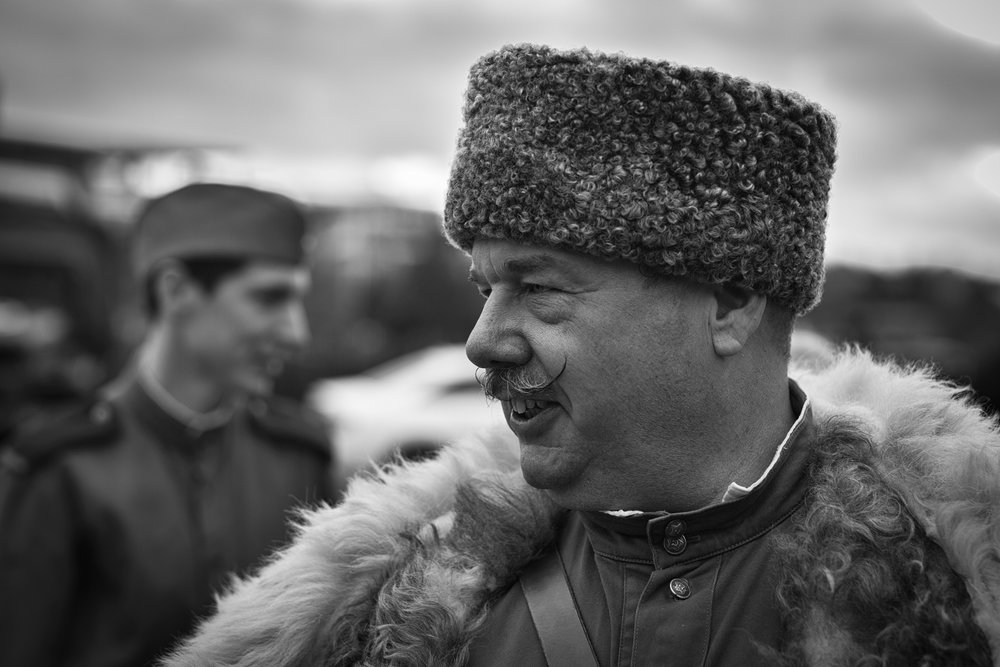Macfilos Weekender with Mike Evans
Every November the Brooklands Museum in Surrey hosts the popular Military Vehicles Day — and you get much more than the mere vehicles on which to practice your photoraphy. The event is a magnet for re-enactment societies, mainly with a World War II flavour. It’s not only Battle of Britain aces and Winston or General Patton lookalikes, it is an opportunity to indulge in some rather convincing role play. On the one side we have WWII German re-enactors, some of whom are dressed to the nines in uniforms that would not be legal in Germany, to a surprisingly large contingent of Red Army troops refighting the Germans on the Eastern front. This rather splendid cossack officer was snapped with a Leica Monochrom (Typ 246) and Leica 50mm Apo-Summicron-M ASPH.


Mike:
One of the items on my bucket list is to attend the annual Shuttleworth Collection show, north of London. I can’t find the date any more on their site, but once a year in the beginning of September(?), they would air out the entire collection. That is a sight I need to see. Given their various other events all year, I would be very happy to live in the shadow of that airfield.
– TR
I went to the Shuttleworth Collection a few years ago with The Leica Society. I will give them a call to try to find out the date you refer to.
When I see or hear the word ‘cossack’, that scene is pretty much what comes to mind. "Pepe LePew of the Don."
He may have been history’s least feared cossack, but in the region my grandmother lived they were the stuff of bedtime legends…."If you are bad, the cossacks (or gypsies) will take you away…"
I was also extremely embarrassed about going out to that strange decaying place – it was a great mercy that it was 90 miles away from my buddies’ notice. So, the connection between the least ‘cool’ place in North America and Bruce Springsteen is particularly rich. Ancien Regime by day, E Street Band by night.
The speakeasy pictures are very professional and glamorous. They’re 8×10 and I would think they used a Graflex of some sort. I haven’t seen them in a couple years, they’re in my mother’s things and I need to scan them.
Beautiful story of a proud woman and her homeland connections,there is, or was, a lot of communities like that in rural parts of America, and that was a good thing, people passing their stories and history to their families.Thank you for sharing!
I love these re-enactment and historical society days. Amazing how much some people love getting "into character". Thanks Mike. And thanks to Tuco as well for a great side-story.
Love the photo! Cossacks in the Home Counties…..love it!
There weren’t too many who could claim to be cossack by WWII. The soviets had a long ‘decosssackization’ program that pretty much wiped them out.
But this did trigger something. In the countryside around New York there were many little ethnic resorts, generally on a lake, which immigrants formed to get away from NYC on weekends. When I was a boy, twice a year we would take my widowed grandmother to see her widowed cousin in the backwoods of New Jersey. Cousin Anna lived near a small, strange White Russian lake resort called Rova Farms. Periodically, the FBI would dig a Russian agent under cover there. Less expected, Bruce Springsteen played there early on and it’s where the band had “their only full-scale, truly scary bar brawl."
My grandmother and Anna were Ukrainian Poles, but the food and language were familiar and the place was full of aging White Russians of similar background and situation, so Dad would take them out to a Sunday dinner there. Each time we walked into the restaurant, Grandma, always elegantly dressed, would say under her breath, ‘I hope he’s not here…."
As we entered and before our eyes could adjust to the interior darkness, an ancient little cossack cavalryman would leap in front of us, grab Grandma’s arm, kiss her hand and, ignoring the rest of us, pull her toward the bar with urgent entreaties in Russian.
The little guy’s uniform was impressive: cartridge loops, dangling gold braid, cavalry britches, tall black boots, and a tall, black, flattened, curly fur cap. He was still pretty quick, too. I never saw him coming.
Dad would step close, tower over the little cavalryman and firmly introduce himself while removing Grandma from his grip. The Cossack would then settle down a bit and go off, look over at our table and periodically interrupt our meal, standing at near attention between Grandma and Anna and ask if she liked the stuffed cabbage or whether he could pour her more wine. Father would then stare him back to the bar. He called him, "the Pepe LePew of the Don."
She had tough and wonderful life. "He’s not a real Cossack" – implying "man." I have ‘table pictures’ of her in furs in a famous NY society speakeasy (’21’) and when Trotsky was mentioned, she would say, present tense, "the sonofabitch owes me $20" from a poker game in NYC. I wish I knew her better as an adult.
I really like Mike’s image, but your story is so much more – so interesting, it says so much about challenge of those who not only survived these regimes, but also settled in other places later on. I would love to see your images.
Sorry Mike – your image is excellent, and why the M interests me as a camera, but I love this story.